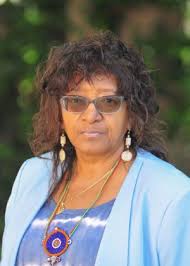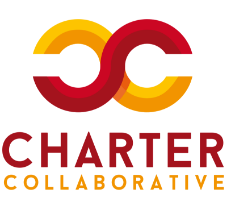
Regina Rodriguez
Executive Director,
Shining Stars Montessori Academy
Public Charter School
Shining Stars Montessori Academy Public Charter School
Location: Washington, DC
Year Opened: 2011
Student enrollment: 300
Grades served: PreK3 – 6th grade
Website: www.shiningstarspcs.org
Student Demographics
Black/African-American: 55%
Hispanic/ Latino: 15%
Asian: 2%
Caucasian/White: 20%
Two or more races: 8%
Homeless Students: 4%
FRPM/FRPL %: 35%
Students with Disabilities: 12%
ELL/ESL Students: 32%
A PASSION FOR FIXING PUBLIC EDUCATION
Though there were educators in my family, it wasn’t my original plan to be a classroom teacher. I wanted to support positive systemic change, from a policy point of view, for communities of color and lesser resourced/marginalized communities. When I started looking at school systems, I thought I would look at it from a macro perspective. Then I began having conversations with children, parents and teachers and the micro perspective lured me into reimagining education.
Over an almost 30 year career I have served as a teacher, an assistant principal, an instructional coach, and most recently as a charter school leader for the last 10 years at Shining Stars Montessori Academy Public Charter School. I have seen how children learn and how schools should work. I have learned that there are very simple reasons why schools can work and some profound reasons why they haven’t worked for some children. I have experienced tremendous challenges as well as tremendous joys. At this stage of my career, some of my joy comes from former students who are now receiving their masters and doctorates and are themselves involved in campaigns to grow quality schools for children who have not had access to them. I’m beginning to see a little bit of that macro legacy that I wanted to create.
I’ve had a professional reputation for being a fixer. School leaders would call me and say, “Can you come in and lead a charette and help this team that is entering a school turnaround phase think through the problems of practice?”
When I was approached by board members of Shining Stars, the mission they had shared was compelling, the possibilities intriguing—and I wanted to see it continue. I had only planned to do this work for a short period of time, but then the school community grabbed my heart. I knew the Montessori pedagogy is unrivaled, particularly in PreK3-6, and I began to see that the nation’s capital was an ideal locale for that kind of school.
When they asked me who I might recommend to lead the school, I considered what it would take—prior experience running schools; solid knowledge of business principles; and an understanding of how children learn, what constitutes quality education, and what materials and resources need to be brought to the table. Realizing that I had experience and knowledge in all of those areas, I volunteered myself. It has been one of the most rewarding decisions I have made.
Today, Shining Stars Montessori Academy is a gem in the charter school crown. It is a culturally-inclusive, globally-focused, dual-immersion, authentic Montessori school that is tuition-free and non-selective. As a result, our close-knit community is beautifully diverse, with representation from dozens of countries and many home languages, as well as the full range of economic backgrounds.
LESSONS LEARNED FROM COVID-19
Throughout this pandemic, I have maintained the same standards for our school as before the COVID-19 shutdown—respect, rigor, high quality, and high performance for our kids. I look at high performance not just in terms of academics but also how we’re growing children as decent human beings, people who see and look out for others in their community, our cities, our country, and our world. That said, there’s no question that COVID has forced us to pivot. We have definitely had to think outside of the box and get creative. My leadership team, our teachers and I are constantly reflecting. If something’s not working for our children, we are prepared to evaluate, modify and jettison what’s not working, and move forward.
Montessori is particularly reliant on unique materials, but we’ve learned to use what can be found in the house. For example, the beads we used for teaching children mathematics, became Cheerios. In the early grades, Montessori prides itself on not being reliant on technology as a teaching or instructional support. While we’re really trying to reserve the use of technology to the upper grades, we have had to rethink this time with the lower grades. We had already been drawn into the 21st century with the standardized assessments being on an online platform, so starting in kindergarten our children had Chromebooks. Yet, it’s been a huge shift for Montessori guides to view the Chromebook as a tool almost like a pencil. I was very pleased that teachers embraced the new learning platforms like Google Classroom—even those who initially struggled.
Montessori’s teacher assessments are based on daily observations. That’s been the area that’s been the focus of constant conversation. How are we checking for understanding? We could use the standardized assessments, but we’re looking at how we can begin to push for more authentic assessments like portfolios. Montessori is evolving to accept multiple metrics of student progress and achievement.
I don’t think in these short six months we’ve come to fully realize the profound change in this pandemic has brought about in education. Even with a vaccine on the horizon, we’re going to have to look differently at schools and learning. The pandemic has really peeled the scab off of everything and forced us to reexamine not just charter schools, but public education writ large. There are some hard questions, and we’re answering some of them. We’re finding new ways to meet our communities’ needs. We have to acknowledge how important it is to authentically bring parents into the equation.
MANATI FELLOWSHIP
One of the ways that Manati was very helpful was introducing the idea of using design thinking and user-centered design to unpeel the onion on problems of practice, and providing a process for starting with an empathy-centered approach and then moving to problem solving and the solution. Manati reminded me of the importance of not jumping to finding a solution until you’ve really looked deeply and introspectively at the problem of practice.
I’ve always said that I lead while Black. It’s always been very clear to me that there are hurdles I’ve had to jump that are a little bit higher. Manati helped look at research-based and practitioner-tested perspectives on racism and antiracism. My administrative leadership staff is diverse— Black girls rock at the top —and my parent body is diverse. We have baked equity into our mission and acknowledged cultural differences as a plus. We start staff everyyear with a session called, “The Baggage We Bring.” It is very powerful and often gut-wrenching, but oftentimes weare able to leave it there. The degree to which some have internalized their learnings about the importance of equityis not always clear to me. Manati has helped me appreciate that equity and social justice must be front and center allthe time. We can never think we’ve solved for them.
Even within the diverse environment that we have at Shining Stars, there are a lot of questions. I have to keep asking, “How are cultural differences reflected in the attitudes staff have and the instruction they provide?” I have dug in even deeper to make sure that the discussions that we’re having are hard and authentic. And it’s not just discussions. It’s also about whether the issues we’re addressing and the solutions we’re proposing are actionable.
Equity starts at the top, with what I communicate about what’s acceptable and what’s not acceptable. I’ve had to look at shifting people in certain positions, getting people additional professional development, and helping people to be more reflective about power dynamics and leadership. Sometimes this is the first time our parents have dealt with a leader of color, or an Executive Director of color who has the final word. Sometimes that involves them working through issues of privilege and fragility, and requires my ability to understand that and stay focused on growing a school community that will work for all children.
I’m also going to treasure the networking with that small group of leaders and those relationships going forward. These folks have my back and have much to offer. There’s a common thread that goes through all of us: we’re professionals of color in the nation’s capital running single site charter schools, leading from the margins. I’m willing to share, but I’m also willing to sit and listen. It was an eclectic mix, but the range of experiences was very helpful for all of us. Our solutions might be different given the circumstances of our schools, but we’re all doing the best we can for our children. None of us is hesitant to say, “I need to know more, I want to know more, and I can always do better.”
Manati provided frameworks that I had forgotten or hadn’t learned, and I was very appreciative of them and examples of how to apply them. It led me to make some shifts in management style to more shared decision-making and bringing in other leaders. Developing a shared vision of success was the capstone for me. I learned how having a shared vision in our organization and in our hearts can help us to lead external stakeholders and not let them drive us.
FUTURE FOCUS, VOICES OF CHARTER LEADERS OF COLOR
If more charter leaders of color get the equitable support they need, the whole world is possible. When you’re attempting to grow and nurture children, you can’t have many missteps. One poorly hired teacher, or a school that’s not properly managed and is not a place where children feel comfortable learning can really set children back. If these rare kinds of networks become part of every generation of leaders, where we know that there’s a pool of people we can call, we will be able to experience and share more success. If there are more of us sharing ideas and experiences and resources, power relationships will shift within our cities. Right now, we’re islands, but that’s something that we can correct.
